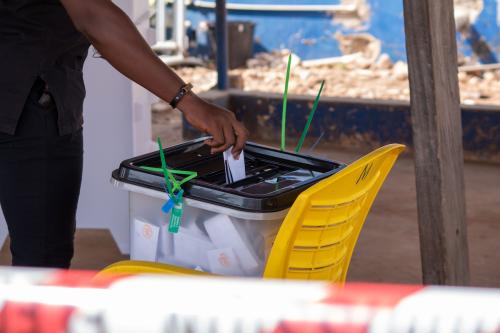Below is a viewpoint from the Foresight Africa 2023 report, which explores top priorities for the region in the coming year. Read the full chapter on food security.
 In 2022, Africa grappled with the impacts of another global food price crisis—the third in the last 15 years. The combined effects of the war in Ukraine, lingering supply chain shortages from the COVID-19 pandemic, and a fourth consecutive season of drought in the Horn of Africa, all contributed to already escalating food and fertilizer prices, causing staple food prices in Africa to increase by, on average, almost 24 percent between 2020 and 2022. Moreover, estimates indicate that over 2022–2023, the rising cost of food and fertilizer will add $9 billion to the import bill of the 48 most affected countries, half of which are in Africa. Food and fertilizer price inflation will likely worsen food insecurity. Already, one in five people in Africa are classified as hungry, and the prevalence of undernourishment in the region has risen by more than 4 percent since 2015—higher than any other region of the world. Those in conflict-affected African countries are, unsurprisingly, the most likely to be living in hunger.
In 2022, Africa grappled with the impacts of another global food price crisis—the third in the last 15 years. The combined effects of the war in Ukraine, lingering supply chain shortages from the COVID-19 pandemic, and a fourth consecutive season of drought in the Horn of Africa, all contributed to already escalating food and fertilizer prices, causing staple food prices in Africa to increase by, on average, almost 24 percent between 2020 and 2022. Moreover, estimates indicate that over 2022–2023, the rising cost of food and fertilizer will add $9 billion to the import bill of the 48 most affected countries, half of which are in Africa. Food and fertilizer price inflation will likely worsen food insecurity. Already, one in five people in Africa are classified as hungry, and the prevalence of undernourishment in the region has risen by more than 4 percent since 2015—higher than any other region of the world. Those in conflict-affected African countries are, unsurprisingly, the most likely to be living in hunger.
Yet, while external factors largely exacerbated the crisis in Africa, improving food security requires tackling longstanding internal factors and structural challenges hindering the region’s agricultural production and constraining households’ access to affordable food. Rapid population growth, changes in consumer tastes, and the demands of domestic agro-processors for certain quality inputs have led to expanding import dependence, especially for wheat, rice, and palm oil. The region’s annual food import bill could go from $50 to $110 billion by 2030 if the status quo continues. Some of this import dependence further reflects the region’s low investments in agricultural research and development (R&D) that could have resulted in higher agriculture yields. Despite both the 2003 Maputo and 2014 Malabo Declarations of the Comprehensive African Agriculture Development Program (CAADP)—in which African governments agreed to spend 10 percent of their annual budgets on agriculture—most spend less than 5 percent on average.
Much of this expenditure goes to subsidy programs rather than to agricultural R&D and extension services, even though the latter generates higher economic returns. Unequal access to land and water resources, low levels of mechanization, and insufficient electricity and road infrastructure are other constraints to the sector’s productivity.
In 2023, African governments and their development partners should revisit the importance of these issues, while also adopting a more holistic approach to enhancing food security: Food system transformation. This approach aims to transform food production in a way that fosters inclusive job creation while promoting both environmental sustainability and better nutrition outcomes, thereby building on priorities that African governments themselves identified for the 2021 UN Food Systems Summit.
Food system transformation: This approach aims to transform food production in a way that fosters inclusive job creation while promoting both environmental sustainability and better nutrition outcomes.
Doing so will require greater progress on several fronts. First, improved intersectoral coordination will be essential since food system transformation touches not only on the mandates of agriculture ministries; but also, those of health, labor, environment, and trade, among others. Second, there will be a need for enhanced intergovernmental coordination between national and local governments, especially in those countries, such as Ghana, Kenya, Nigeria, and Zambia, where certain responsibilities for agriculture and health have been legally devolved to subnational authorities. Third, there is scope to go beyond the farm, considering options to improve food safety and working conditions in informal retail markets, which is where most of the urban poor (an expanding demographic) access their food in Africa. Finally, all of these interventions require strong empirical and governance foundations, including data that can help anticipate trade-offs among different food system goals and budget tracking systems that can improve accountability, as well as ensure food system commitments are transparently translated into actions.




Commentary
Recurrent food crises underscore the need for food system transformation
August 2, 2023